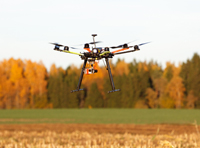
BizTech Law Blog
 The Federal Aviation Administration (FAA) just released proposed rules regarding unmanned aircraft systems ("UAS" or "drone") in United States airspace. The rules are not final, and the FAA is expecting public comments regarding the proposed rules in the next 60 days.
The Federal Aviation Administration (FAA) just released proposed rules regarding unmanned aircraft systems ("UAS" or "drone") in United States airspace. The rules are not final, and the FAA is expecting public comments regarding the proposed rules in the next 60 days.
The current unmanned aircraft rules will remain in place until the final new rule is approved by the FAA.
Here is a quick summary of what the FAA proposed. The stated goal of the new rules is to balance aviation safety with the regulatory burden on UAS operators.
- The UAS must weigh less than 55 pounds.
- Operations are limited to daylight-only (sunrise to sunset).
- The operator of the UAS must maintain a visual line of sight at all times. An observer is allowed and recommended, but not required. The FAA requested comments regarding whether operations should be allowed beyond the line of sight of the operator.
- An operator would have to be at least 17 years old, pass an aeronautical knowledge test and obtain an FAA UAS operator certificate. To maintain certification, the operator would have to pass the FAA knowledge tests every 24 months. A small UAS operator would not need any further private pilot certifications (i.e., a private pilot license or medical rating).
- The UAS operator must always stop the flight if there is a hazard to other aircraft, people, or property.
- The drone may not fly over people, except those directly involved with the flight.
- Flights should be limited to 500 feet altitude and no faster than 100 mph.
- Operators must stay out of airport flight paths and restricted airspace areas, and obey any FAA Temporary Flight Restrictions (TFRs).
- No object may be dropped from the drone or UAS.
- Operators may not use the drone in a reckless or careless manner.
The new rules would not apply to model aircraft. However, model aircraft operators must continue to satisfy all of the criteria specified in Sec. 336 of Public Law 112-95, including the stipulation that they be operated only for hobby or recreational purposes.
Here is a link to the FAA summary of the proposed rules: https://www.faa.gov/regulations_policies/rulemaking/media/021515_sUAS_Summary.pdf
